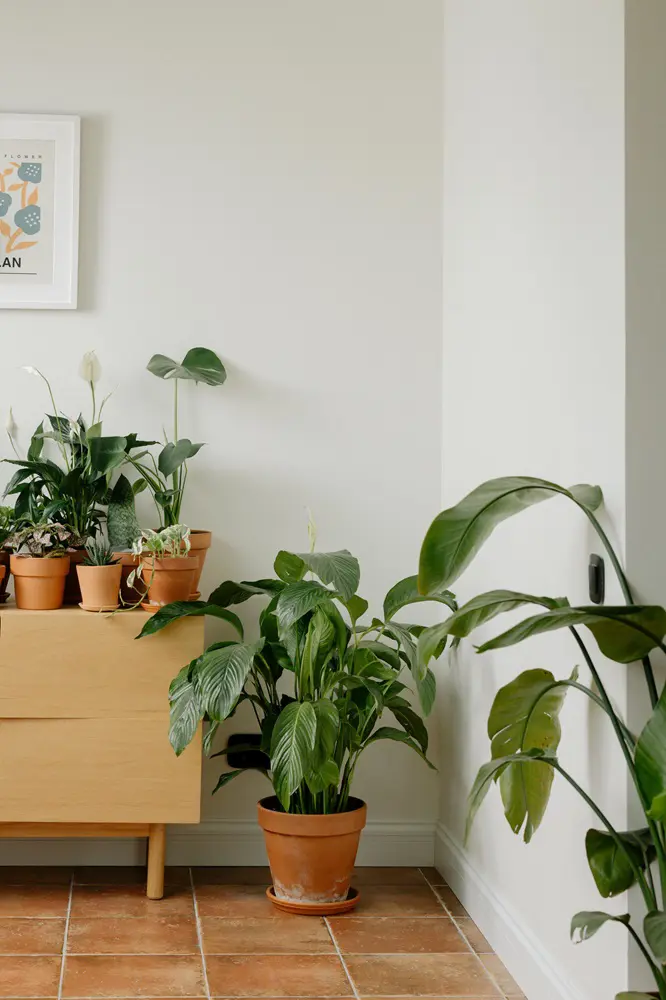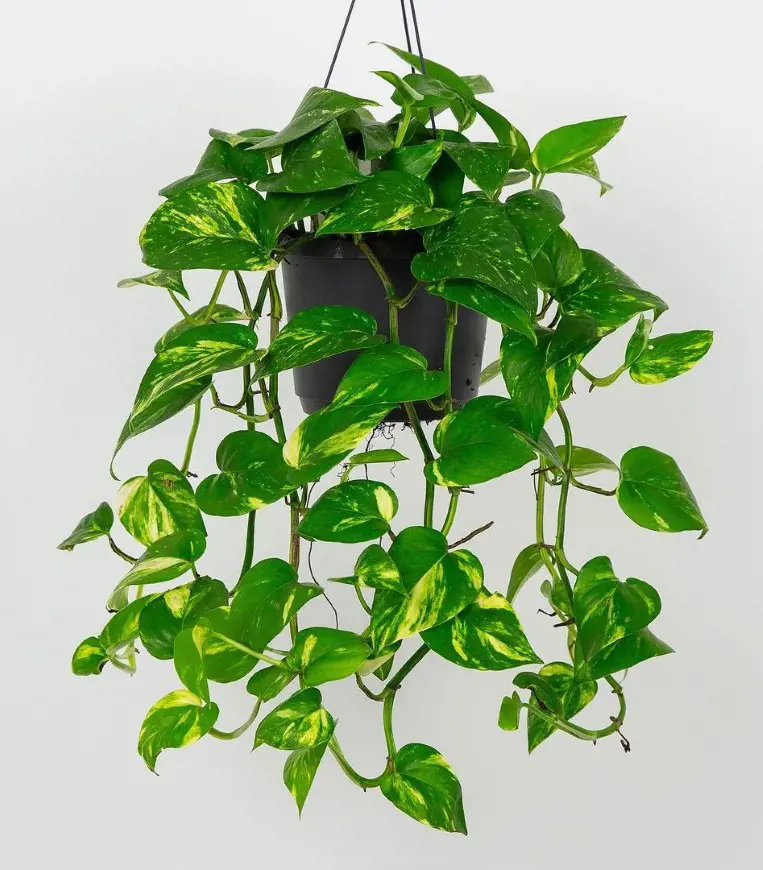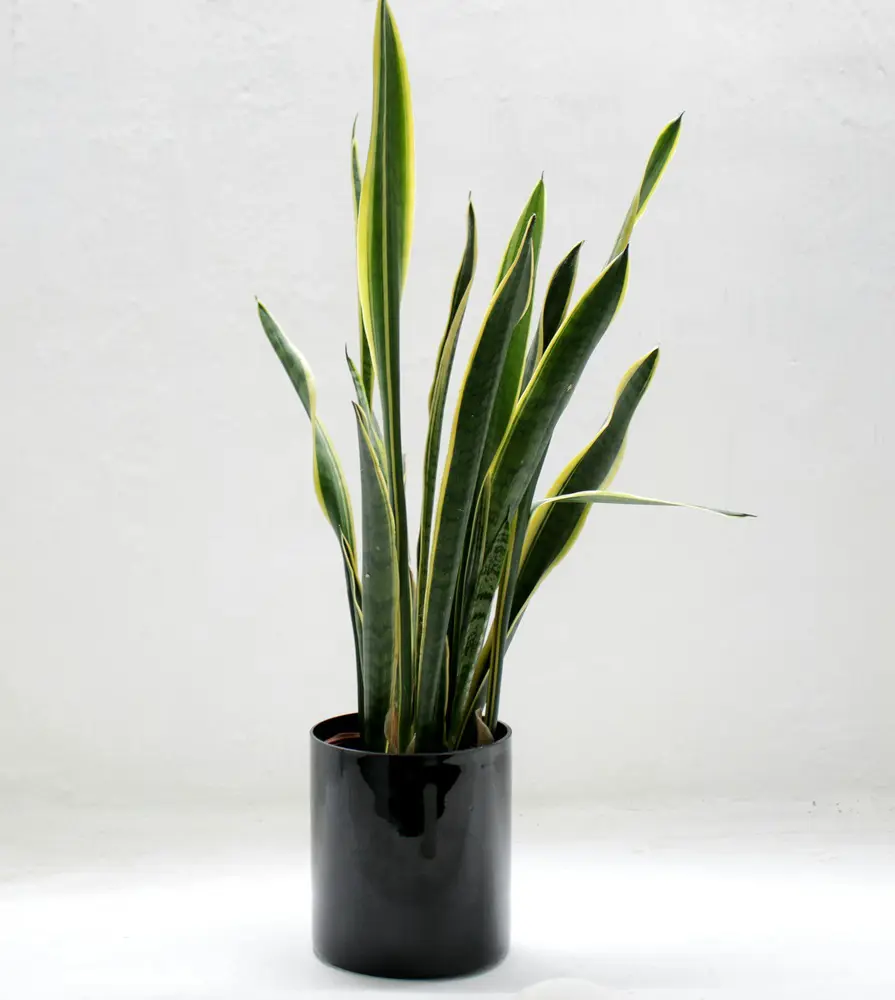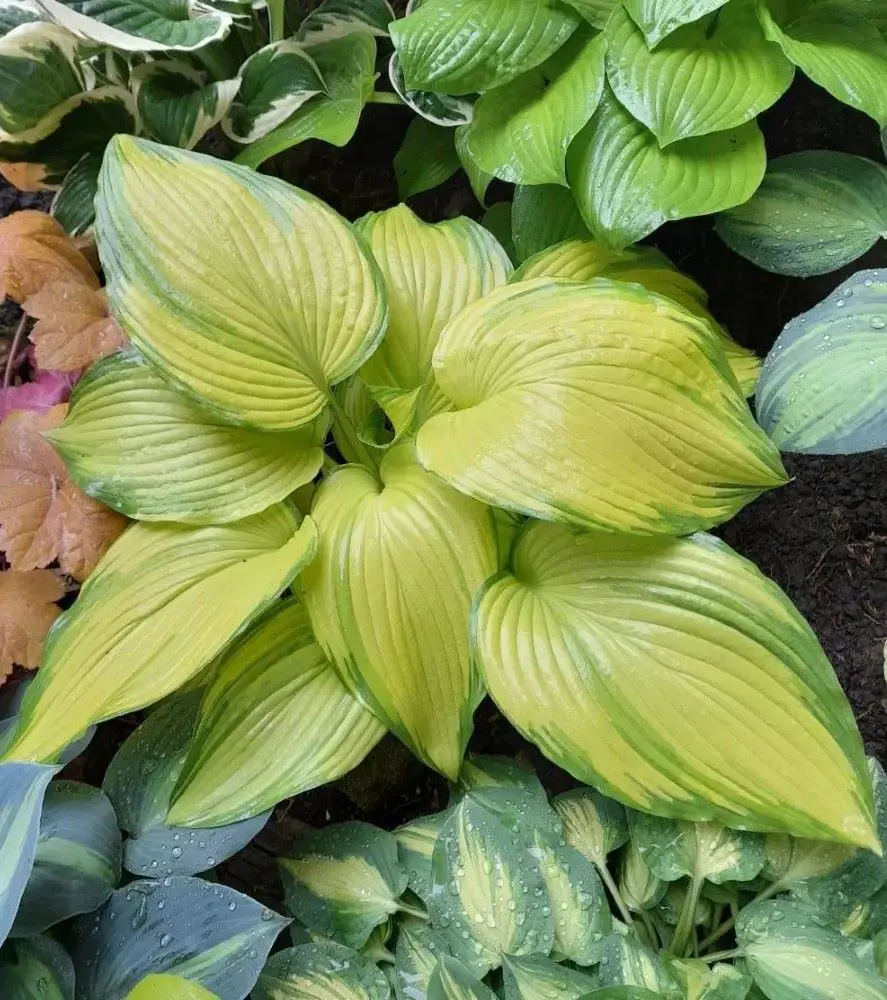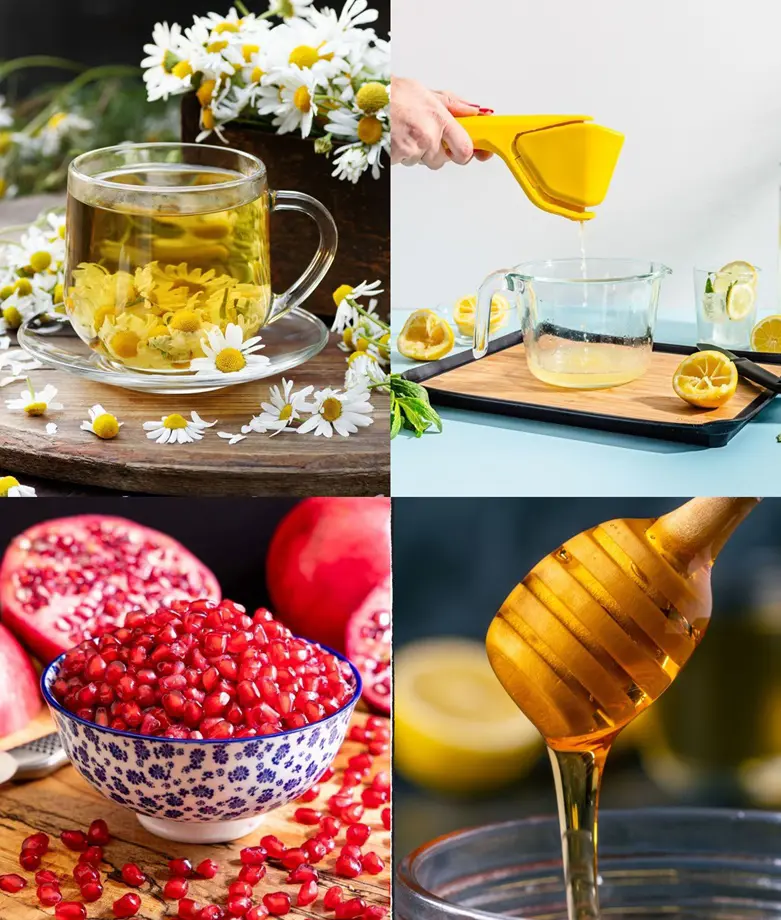Reasons Why Tomato Leaves Are Turning Yellow
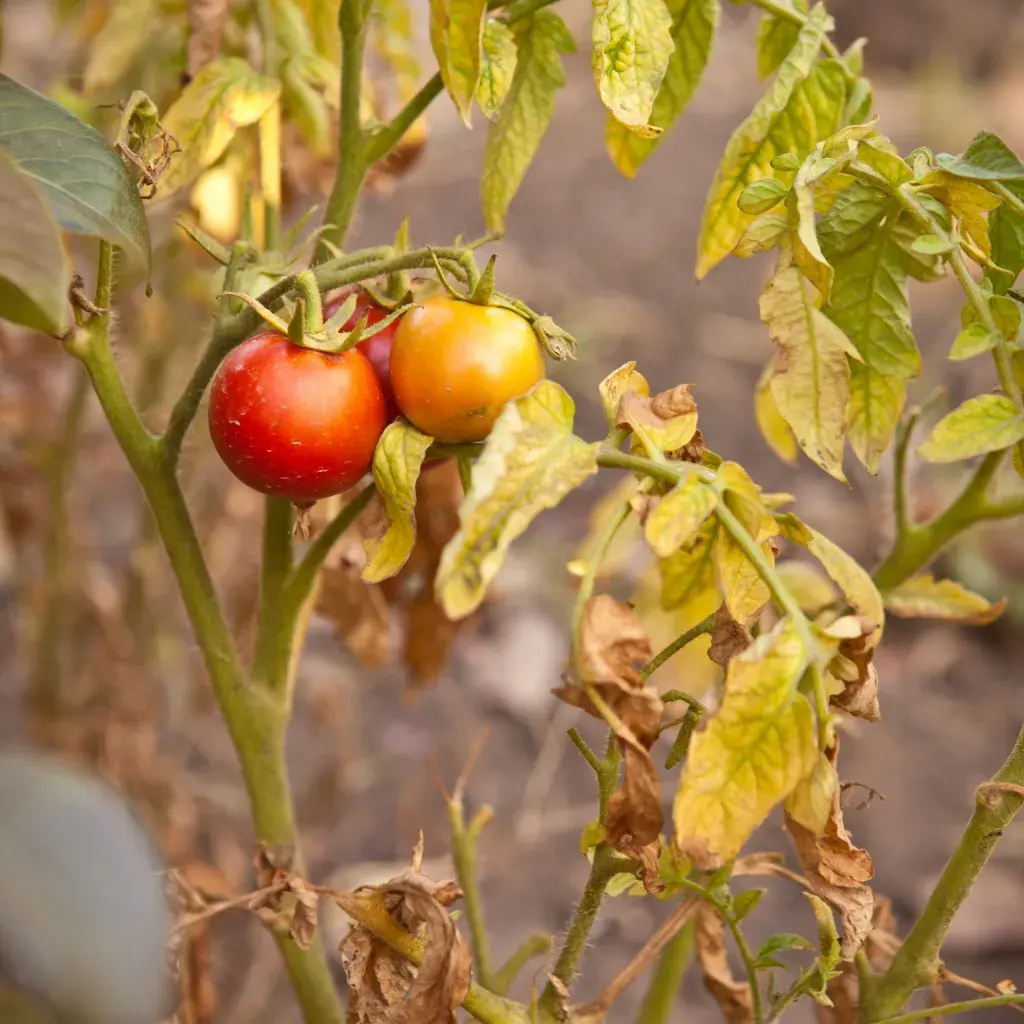
This post may contain affiliate links. If you make a purchase through links on our site, we may earn a commission.
If your tomato leaves are turning yellow, it's a cause for concern when you've put effort into growing them for that homegrown, delicious taste. The yellowing could result from various issues affecting your kitchen garden aspirations.
Our guide simplifies it for you, offering insights into why this happens and practical solutions. Identifying the problem is the first step in rescuing your tomatoes from this yellow predicament.
Remember, your homegrown tomatoes can be tastier than store-bought ones, so addressing the yellowing issue is crucial to ensure a successful and flavorful harvest.
Yellow Tomato Leaves
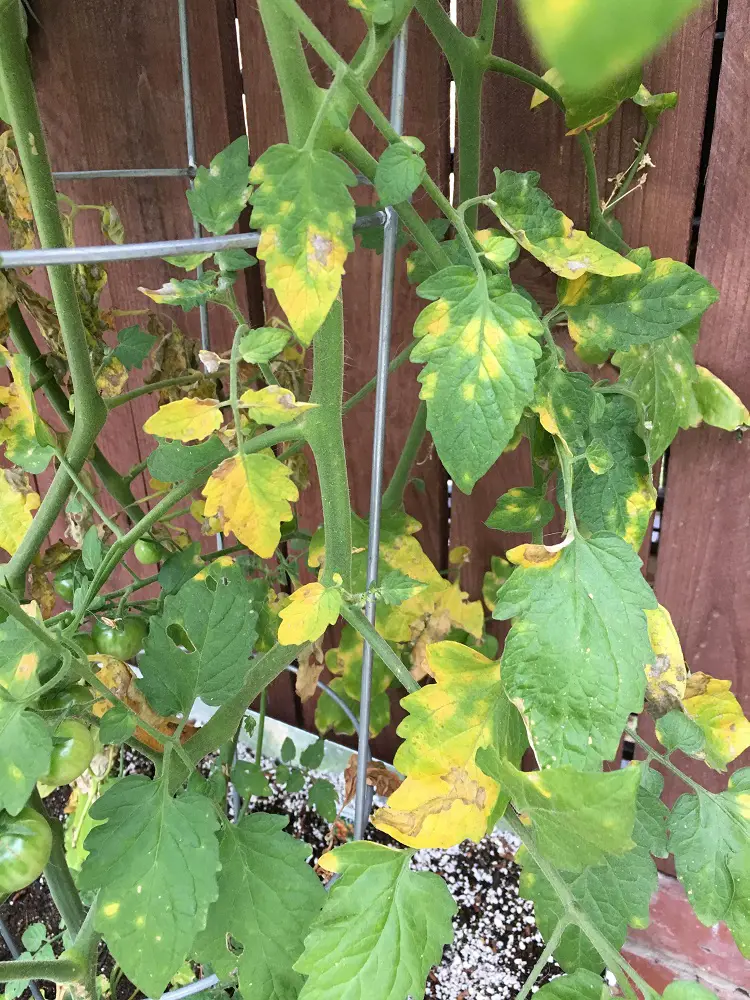
The bright side of tomato leaves turning yellow is that most issues causing this can be fixed. When you're pruning tomato plants, it's generally a good practice to remove yellowing leaves.
Now, let's delve into why leaves turn yellow. Understanding these details is crucial for maintaining a healthy tomato crop. By addressing the root causes behind the yellowing, you can take steps to remedy the situation and ensure your tomato plants thrive.
Proactive care and timely removal of yellow leaves contribute to a more robust and fruitful garden.
Nutrient Deficiency
Tomatoes crave a well-balanced diet, particularly nitrogen, magnesium, and iron. A shortage of these nutrients can lead to yellowing leaves.
- Nitrogen: Insufficient nitrogen displays as yellowing in older leaves.
- Magnesium: Older leaves show a speckled yellow pattern with magnesium deficiency.
- Potassium: Yellow margins on green leaves signal a potassium shortage.
- Iron: Inadequate iron results in younger leaves turning yellow.
- Zinc: Young tomato plants may exhibit yellowing between leaf veins and stunted growth.
Nutrient deficiency occurs most often on older plants that are bearing fruit. Beware of overfeeding, which can cause lush plants at the expense of fruit.
Care Tips
- Use a balanced fertilizer rich in nitrogen, magnesium, and iron.
- Fertilize at planting and monthly during the season, as tomatoes are big eaters.
- Read and follow fertilizer instructions carefully to avoid overfeeding.
- Ensure your soil has enough nitrogen, phosphorus, and potassium for overall plant health.
Overwatering or Underwatering
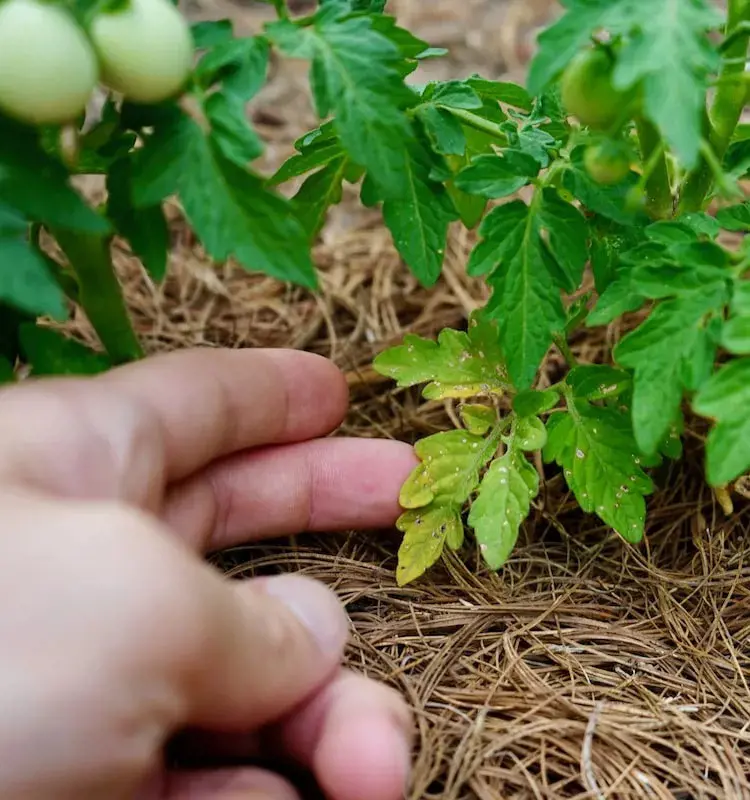
Tomatoes, like us, prefer a perfect balance of water. They generally thrive on 1 to 2 inches of water weekly. If your tomato plants are in sandy soil, they might need a bit more, while those in loamy or clay soil are content with around 1 inch.
Here's the catch: too much or too little water can both turn those green leaves yellow. So, it's like finding the Goldilocks zone for your tomatoes.
Care Tips
- Before watering, assess soil moisture by sticking your finger 2 inches below the surface at the base of the plant.
- If the soil feels moist, hold off on watering and recheck the next day.
- Water when the soil 2 inches deep is dry to the touch.
- Opt for a slow, prolonged watering method rather than a quick splash. This encourages deep-root development, making plants more resilient to drought.
- Promote a deep root system for better water absorption and drought tolerance.
Sunburn
When tomato plants receive excessive sun exposure, the leaves can get scorched, turning yellow or even brown. This occurs because intense sunlight damages the chlorophyll, the green pigment crucial for photosynthesis.
The plant's ability to produce food is impaired, resulting in yellowing leaves. To prevent sunburn, provide some shade during the hottest parts of the day, especially in scorching climates.
Care Tips
- Shield tomato plants from excessive sunlight, especially during the hottest parts of the day.
- Ensure consistent and sufficient watering, as hydrated plants are more resilient to sunburn.
- Use physical barriers like row covers or plant taller crops nearby to provide natural shade.
Transplant Shock
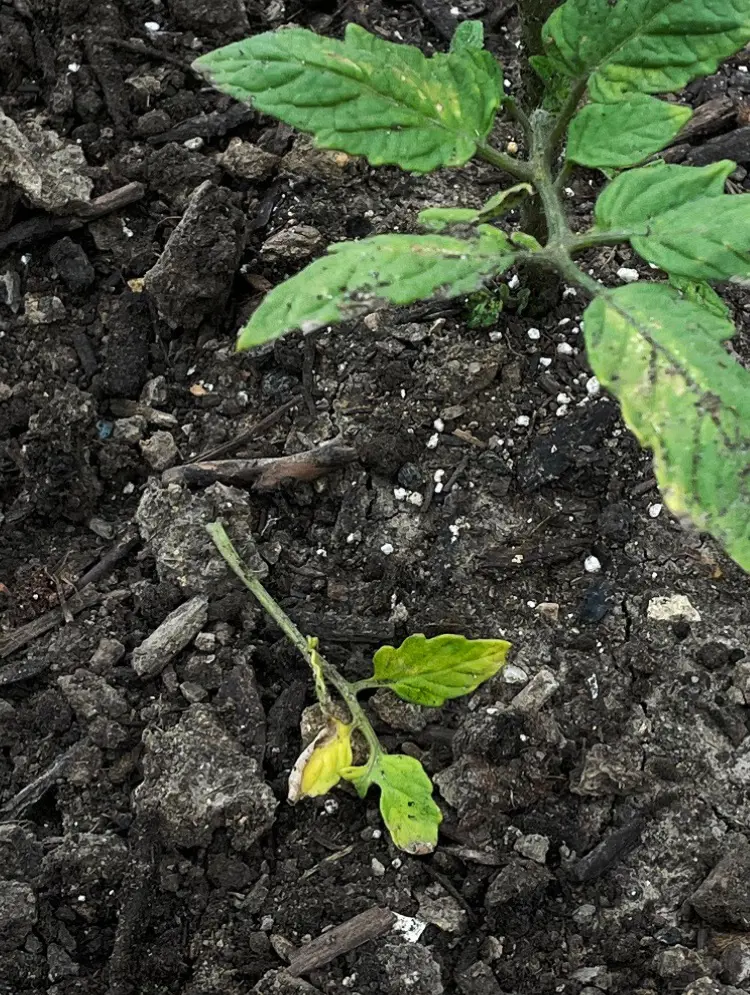
When you transplant young tomato plants, they might experience transplant shock, causing their leaves to turn yellow. If yellow leaves appear after transplanting, it's often a temporary adjustment period.
Don't fret if the plant is generally healthy; it's likely to resolve on its own. Just give it time and continued care, and soon, your tomatoes should bounce back, green and thriving in their new environment.
Care Tips
- Keep the soil moist but not saturated for thriving seedlings.
- Within about 4 weeks, encourage an extensive root system. Transition to deep watering once or twice a week during dry spells.
- Shield young plants from cold temperatures. If nightly lows dip below 45°F, cover them with a bucket or box, uncovering them in the morning.
Pests
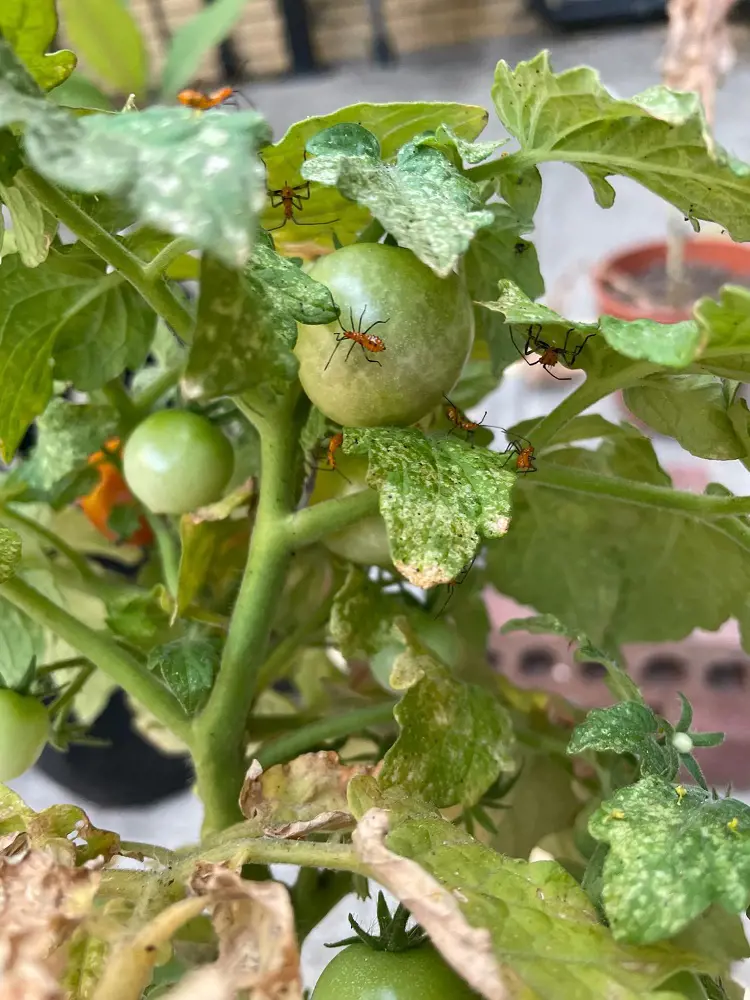
Garden pests like aphids, thrips, spider mites, flea beetles, and whiteflies can turn your tomato plants yellow. These troublemakers munch on your plants, causing localized yellowing near their feeding spots.
Aphids suck plant sap, making leaves twist and turn. Thrips, with their tiny size, puncture cells and lead to leaf discoloration. Spider mites, though not insects, create yellow speckles as they feast on plant cells. Flea beetles leave small holes in leaves, turning them lace-like and yellow. Whiteflies, attracted to plant sap, cause wilting and yellowing.
Care Tips
- If pests are spotted, consider using insecticidal soap or neem oil promptly.
- Apply treatments directly to the affected areas where pest-induced yellowing is observed.
- Implement preventive measures, such as tomato companion planting or introducing beneficial insects, to deter pests and minimize the risk of yellowing.
Fungal And Bacterial Diseases
If everything is for your tomato plant, yellowing could indicate a disease. The following bacterial and fungal infections can result in yellowing of the leaves:
- Early Blight: Caused by Alternaria tomatophila and Alternaria solani, it presents as brown spots with yellow edges, primarily on older leaves.
- Late Blight: Recognizable by large, oily-looking lesions on both leaves and stems, though it's a rare but destructive disease.
- Septoria Leaf Spot: Induced by the fungus Septoria lycopersici, it starts with small, dark-bordered spots on lower leaves, eventually turning them yellow and causing them to fall.
- Leaf Mold: Caused by Passalora fulva, shows as yellow spots on older leaves, growing larger over time and turning the leaves mostly yellow.
- Fusarium Wilt: Induces wilting and yellowing of lower leaves, often starting on one side of the plant.
- Verticillium Wilt: Appears as a yellow v-shaped pattern on older leaves, spreading to brown and causing leaf drop.
- Bacterial Leaf Spot: Characterized by water-soaked spots that may develop a yellow margin.
Care Tips
- Opt for tomato varieties that are resistant to common diseases to reduce the risk of yellowing.
- Apply fungicides preventatively, especially during the growing season, to shield plants from fungal infections causing yellow leaves.
- Practice good garden hygiene by removing and disposing of infected plant material promptly and learn to fix tomatoes from diseases.
Herbicide Damage
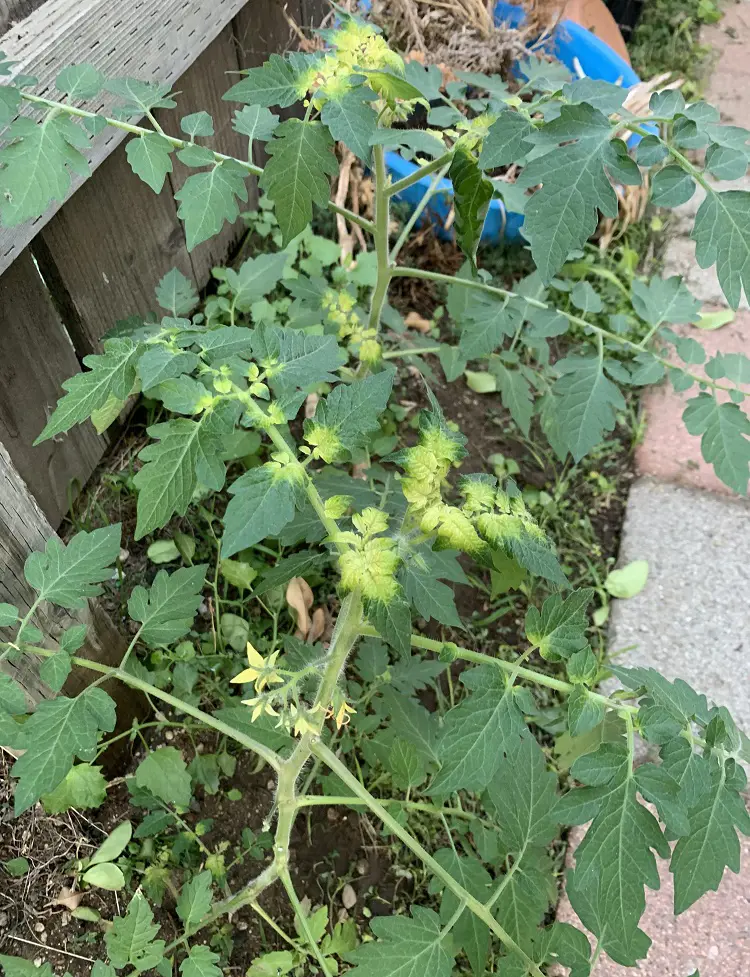
Watch out for weed killers near your tomatoes; they can harm them! Even a little drifting from nearby use can turn tomato leaves yellow, sometimes with white patches.
This happens fast, starting from the inside of the leaf and spreading towards the edges. So, be careful when using weed killers close to your tomatoes.
Care Tips
- Steer clear of using weed killers near tomatoes. The volatile compounds can travel through the air, impacting plants even at a distance.
- Be mindful of breezy conditions, as herbicide drift can travel long distances.
- Safeguard your tomato plants by creating a herbicide-free zone around them.
Root Damage
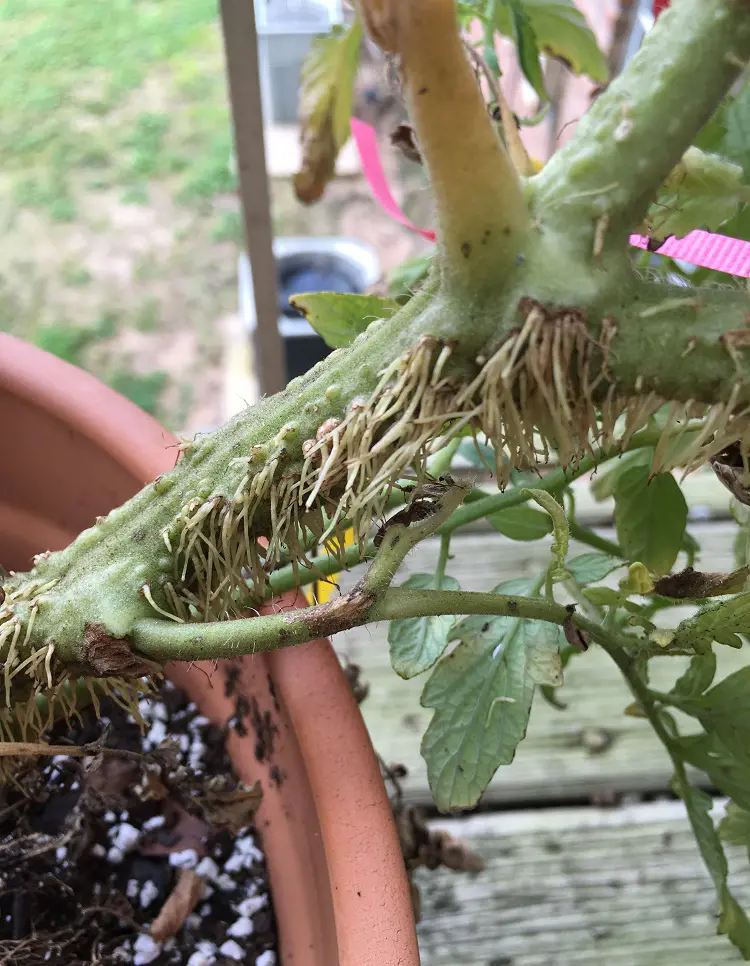
When tomato roots face harm from activities like digging, pests, or diseases, it affects their ability to absorb essential nutrients, leading to the yellowing of leaves.
If these pipelines get damaged, the flow of nutrients is disrupted, and the plant can't get the nourishment it needs.
Care Tips
- Apply organic mulch around tomatoes to regulate soil conditions and reduce the need for excessive digging.
- Maintain consistent, deep watering while ensuring good drainage to prevent waterlogged roots and enhance overall root health.
- Consider planting in raised beds or containers with well-draining soil to reduce the risk of soil compaction and root damage.
Temperature Stress
When it gets colder than 55°F, your plants might not be too happy. Low temperatures can slow down their growth and make their leaves change color; they might turn yellow or even get a purple tint.
So, if you notice your pants looking a bit off and the thermometer is reading below 55°F, it's a sign they might need some warmth.
Care Tips
- Plant tomatoes post-last frost for warmer conditions, reducing the chance of temperature stress.
- Choose tomato varieties adapted to your climate for better temperature resilience.
- Apply organic mulch and use protective row covers during cold nights to prevent temperature-induced stress.
Excessive Pruning
Cutting off too many leaves from your plants, known as excessive pruning, can make their leaves turn yellow. When you chop off too many of them, the plant gets stressed out and shows it by changing color.
Care Tips
- Trim selectively, focusing on lower, older leaves to redirect the plant's energy to newer growth.
- Prune during early or late spring to minimize stress on the plant and promote quicker recovery.
- Keep pruning tools clean by sterilizing them before and after each use. This prevents disease spread and ensures efficient healing for the plant.
Improper pH Levels
When the dirt your tomatoes grow in is too acidic or too basic, it can mess up their food supply, making the leaves turn yellow. If the pantry is too sour or too sweet, it's like the tomatoes can't pick out their favorite snacks.
So, you need to be a bit of a chef and check the soil's pH, which is like the pantry's taste. Adjust it to the recommended level for tomatoes (around 6.0 to 6.8).
Care Tips
- Test soil pH frequently to catch imbalances early.
- Use lime or sulfur to adjust the pH if it's too high or low, following product instructions.
- Add compost and mulch regularly to stabilize pH and improve soil quality.
Variety Specific Traits
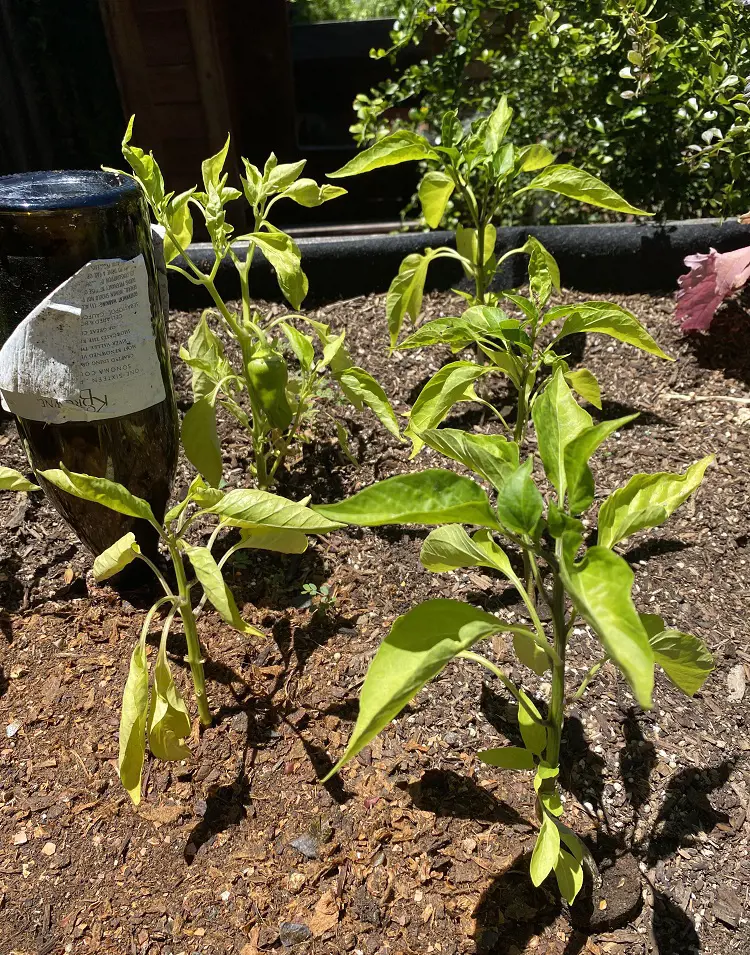
Don't jump to conclusions if your tomato leaves look yellowish-green; it might just be a trait of the tomato variety you planted. Different types of tomatoes come in various shades of green, and some naturally have a yellowish tint to their leaves.
Before worrying about plant problems, take a moment to identify the specific variety you're growing. Each type has its unique characteristics, and what might seem like an issue could simply be a normal feature of your tomato plant.
So, celebrate the diversity of tomato varieties and only intervene if you notice changes that aren't typical for your chosen type.
Tomato Plant Care Tips
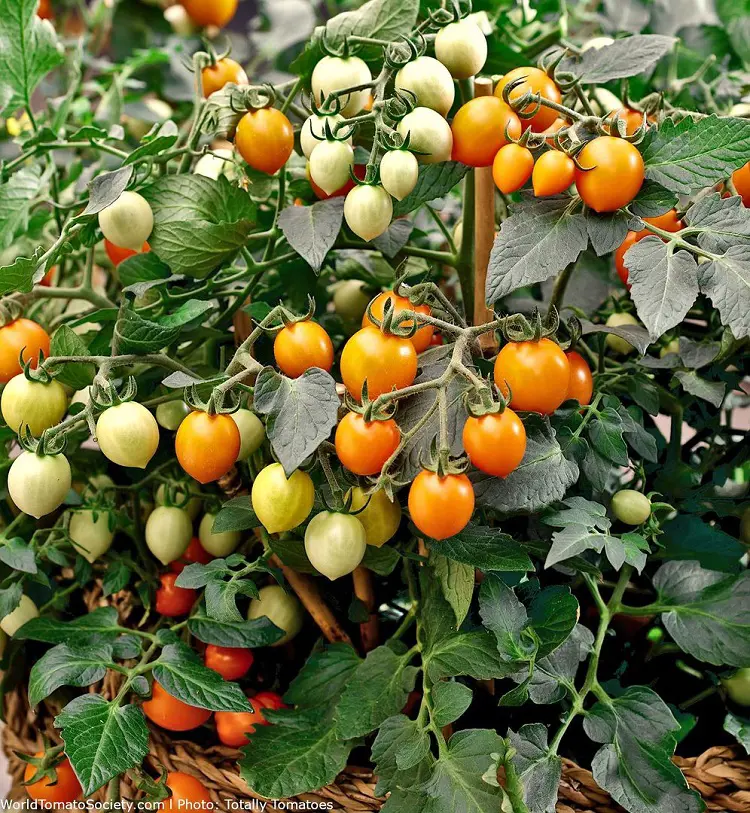
Here are some basic tomato plant care tips that you can follow while growing tomatoes in your home garden:
Planting
Start seedlings indoors 6-8 weeks before the last frost in your area. Transplant outdoors when the soil temperature reaches at least 60°F. Acclimate seedlings to outdoor conditions gradually for a week before transplanting.
When planting, bury the stem up to the first set of true leaves. This encourages stronger root growth.
Watering
Direct water to the soil around the base of the plant, avoiding the leaves to prevent fungal diseases. These methods are more efficient and conserve water compared to overhead watering.
Mulching
Organic mulches like straw, wood chips, or compost are all good options. Apply a 2-3 inch layer of mulch around the base of the plant, leaving a few inches of space around the stem.
Pruning
Remove suckers weekly to prevent them from competing with the main stem for nutrients and sunlight. Once fruits begin to set, prune off lower leaves to improve air circulation and reduce disease risk. Learn how to prune tomatoes to produce more fruits.
Caging or staking
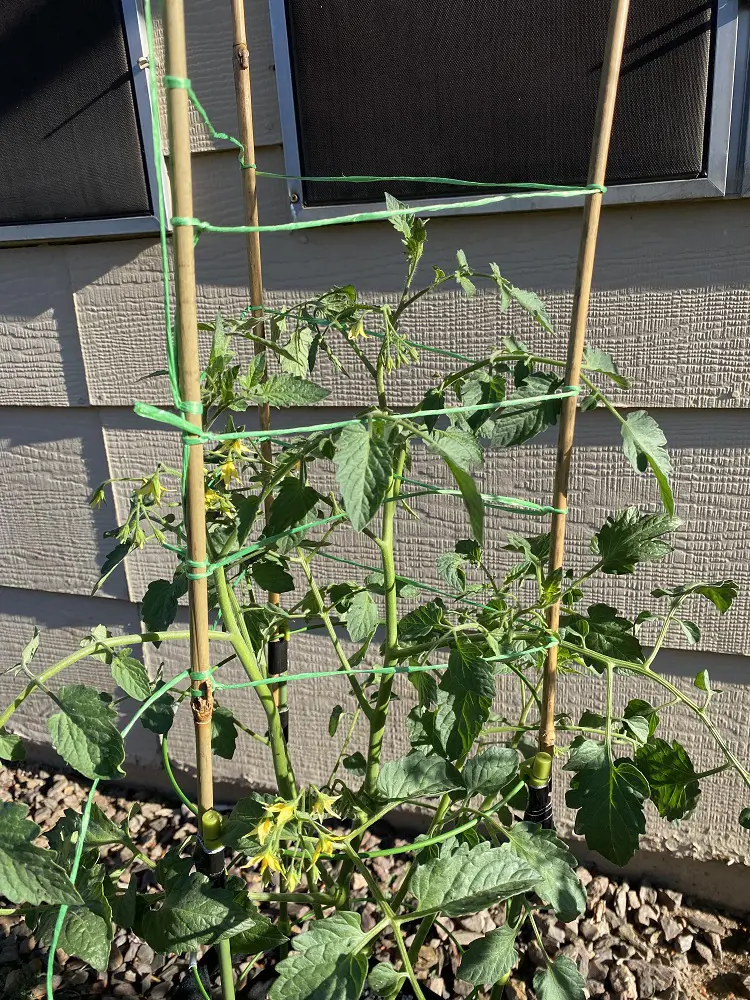
Cages, stakes, or trellises can all be used to support tomato plants. Choose the method that best suits your variety and garden layout. As the plant grows, tie it to the support structure loosely to prevent damage.
Additional Tips
- Planting tomatoes in the same location year after year can deplete soil nutrients and increase disease risk. Rotate crops with other vegetables each year.
- Consider planting herbs like basil or marigolds near your tomatoes to deter pests naturally.
- Regularly inspect your plants for signs of problems and take action promptly to control them.
Fertilizing Guide
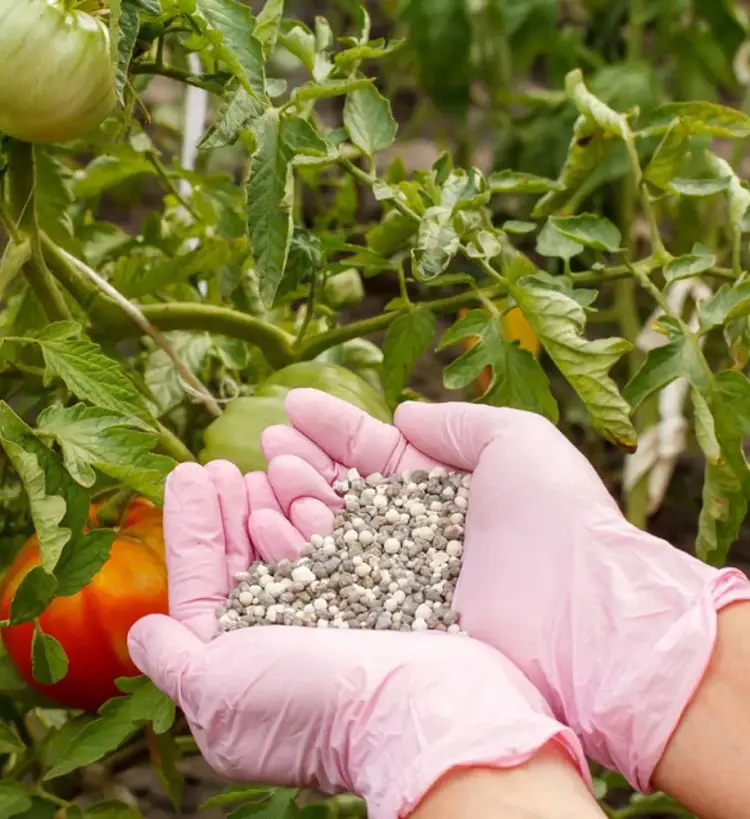
Follow the given fertilizing guide to provide proper care to your tomato plant:
1. Balanced Start: Begin with a fertilizer rich in nitrogen, phosphorus, and potassium when you plant. Follow the label's recommended dosage.
2. Seasonal Boost: Throughout the season, especially when your plants are producing fruit, give them an extra boost with more fertilizer. Opt for one higher in potassium to enhance fruit development.
3. Go Organic: Choose organic options like compost, aged manure, or fish emulsion as alternatives to chemical fertilizers.
4. Beware of Overdoing It: Don't go overboard with fertilizer. Too much can harm the roots and stunt plant growth.
5. Soil Check: Regularly test your soil's pH and nutrient levels to tailor your fertilizing plan to your garden's specific needs.
- Remember: Early diagnosis and intervention are key to preventing yellowing tomato leaves. By identifying the cause and taking appropriate action, you can keep your tomato plants healthy and productive.
How To Prevent Tomatoes Yellow Leaves
To prevent tomatoes from having yellow Leaves, start by choosing healthy seedlings in spring. Look for green, disease-tolerant ones, avoiding wilted or yellowing plants. If planting from seeds, ensure they are free from pathogens.
Use a sturdy staking system, space plants well for good air circulation, and fertilize appropriately. Keep the area weed-free, avoid overhead watering, and rotate crops every three years. Plant your tomatoes in slightly acidic soil with a pH between 6.2 and 6.8, or in well-draining soil with organic matter.
Provide monthly feedings with calcium nitrate for robust growth. These steps ensure your tomatoes stay healthy and vibrant.
Conculsion
If your tomato leaves turn yellow, don't worry! As we've discussed, most reasons are fixable. Armed with this knowledge, you can pinpoint the issue. Combine it with your watering and fertilizing routine, eliminate possibilities one by one, and observe how your plant responds.
Take it step by step; fix one thing and see how the plant reacts. If the problem persists, try the next solution. The bright side is that serious issues like diseases or pests are easy to identify.
So, stay calm, and be patient, and your tomatoes will likely bounce back to their healthy, green selves.
Recent posts
Plant Care
Plant Care
How To Take Care Of An Orchid Plant? 11 Tips And Tricks
If you love gorgeous orchids but are worried they're too high-maintenance, don't worry. This guide is like a cheat sheet for orchid newbies. Forget fancy words and confusing schedules — we're talking about how to take care of an orchid pla...
Plant Care
How To Grow and Care For Peace Lily Plant
The Peace Lily is an indoor plant that is most valued for its beautiful and shiny green leaves as well as the white blooms. Hard and tolerant, it’s naturally a low-maintenance addition to your plant collection. If you are confused, let us tell ...
Plant Care
Pothos Plant Care And Growing Guide
Adding a Pothos plant (Devil’s Ivy) to your home benefits the environment and aesthetic of your personal space. It's easy to maintain and is loved for it's ability to enhance indoor air quality by removing toxins like formaldehyde, benzene, and...
Plant Care
Snake Plant Care and Growing Guide
Snake plants require low maintenance, and low light and are almost impossible to kill, making them a perfect plant for beginners and seasoned gardeners. In this guide, we will explore essential care tips and optimal growing conditions for snake plant...
Plant Care
How To Plant, Grow and Care Majesty Palm
The majestic palm, scientifically known as Ravenea rivularis, makes for a stunning indoor tree with its lush and grand fronds. Originating from Madagascar's river banks, this resilient houseplant is cherished not only for its beauty but also for its ...
Plant Care
How To Grow And Care For A Hosta Plant
Hosta plants are widespread perennials, often grown for their beautiful and diverse foliage. They are extremely easy to care for and can thrive in various conditions, particularly shade or semi-shade. These hardy plants can last for many years and re...

